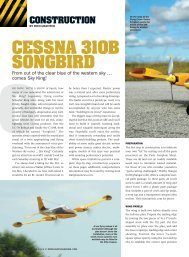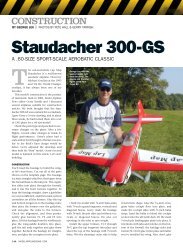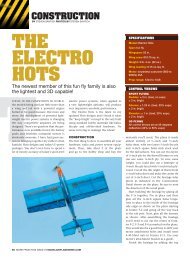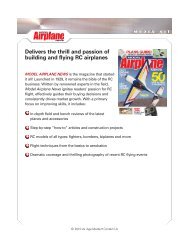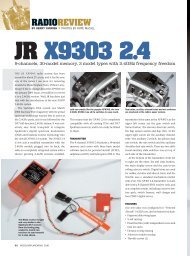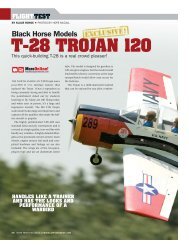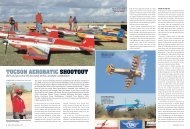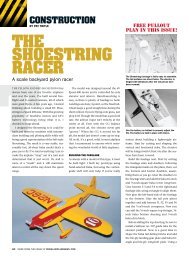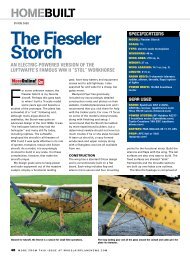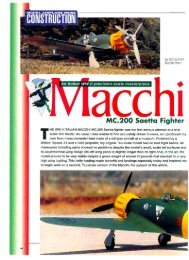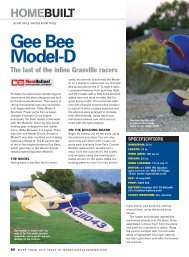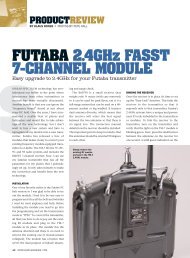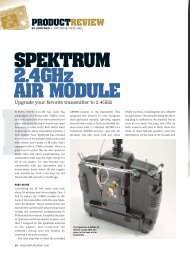You also want an ePaper? Increase the reach of your titles
YUMPU automatically turns print PDFs into web optimized ePapers that Google loves.
HANGAR 9 ARESTI 4D<br />
The Aresti can accommodate a wide range of engines in the<br />
recommended range. I used a Saito FA .72 for stunning<br />
performance.<br />
Here's how the Aresti 40 comes out of the box.<br />
FUSELAGE<br />
The fuselage is complete out of the box<br />
and requires very little preparation. 1<br />
mated the completed wing to the fuselage<br />
and carefully aligned it. The leading edge<br />
of the wing keys into a fuselage bulkhead,<br />
and the rear of the wing is secured to the<br />
L±J<br />
U<br />
z<br />
D<br />
LJ<br />
LL<br />
h<br />
A place for everything and everything in its place. The servo tray is already installed for<br />
quick assembly. Note that the battery and receiver are wrapped in foam to protect<br />
them from vibration.<br />
fuselage by a single '/4-20 nylon bolt that<br />
screws into a blind nut.<br />
The 2-piece aluminum landing gear is<br />
bolted onto the fuselage bottom with six<br />
bolts that screw into pre-installed blind<br />
nuts. I bolted the axles onto the landing<br />
gear and installed the wheel pants and<br />
wheels on the landing gear through an<br />
included plywood plate that I laminated<br />
to the inside of the wheel pants.<br />
TAIL GROUP<br />
Next, the horizontal and vertical stabilizers<br />
are mounted to the fuselage. First, I<br />
removed the covering material from the<br />
slots in the fuselage and then inserted and<br />
aligned the horizontal stabilizer. When 1<br />
was satisfied with it, I removed the covering<br />
material from the center section of the<br />
stabilizer and epoxied the stabilizer into<br />
TAKEOFF AND LANDING<br />
After checking out the controls, I started the big Saito and taxied<br />
the Aresti out to the center of the runway, where I gradually<br />
advanced the throttle and held full up-elevator to keep the tail<br />
on the ground while accelerating. As soon as the speed picked<br />
up, I neutralized the elevator and held in a touch of right rudder.<br />
The Aresti tracked smoothly and predictably and, with slight pull<br />
of the elevator, it rotated and began to climb out. I was immediately<br />
impressed with<br />
the smooth responsiveness<br />
of this plane.<br />
With its low wing<br />
loading, the Aresti felt<br />
very solid and,<br />
because of its clean<br />
design, it doesn't<br />
bleed off speed<br />
quickly when landing. To avoid a lot of float after flare, landing<br />
approaches should not be too steep or too fast. The Aresti slows<br />
down nicely, though, and a gradual application of elevator just<br />
before touchdown makes for smooth landings.<br />
58 MDDEL AIRPLANE NEWS<br />
the fuselage. The vertical fin is mounted<br />
using the same process. Following the<br />
manual, I hinged the elevators and rudder,<br />
installed the tailwheel assembly and<br />
added the control horns.<br />
ENGINE, TANK AND COWL INSTALLATION<br />
The supplied universal aluminum motor<br />
mount can accommodate a variety of<br />
engines, and the Saito .72 I used fit easily.<br />
The supplied throttle linkage is a flexible<br />
stranded cable that's routed through a<br />
plastic guide tube and is attached to the<br />
carburetor throttle arm with a screw-lock<br />
connector.<br />
The fuel tank fits into the fuselage<br />
against the firewall; I set it up using a twoline<br />
system and then routed the lines<br />
through the firewall and center opening<br />
of the engine mount. This opening is<br />
LOW-SPEED PERFORMANCE<br />
The Aresti has a low wing loading with generous control-surface<br />
area; these help contribute to solid and predictable performance<br />
at slow speeds. The model has no tendency to snap at stall and<br />
is solidly predictable.<br />
HIGH-SPEED PERFORMANCE<br />
The Aresti is happy at full throttle and remains solid and<br />
smooth; it does not attempt to snap out of high-load maneuvers.<br />
Top speed with the 12x8 propeller in level flight is about<br />
70mph.<br />
AEROBATICS<br />
This is where the Aresti shines. It is a smooth-tracking plane and<br />
has no tendency to go off on its own. In other words, it flies<br />
where you point it. It has a fast roll rate on high rates and is<br />
very smooth at low rates. Knife-edge tracking is virtually perfect,<br />
with insignificant tuck to the wheels or canopy. Spin recovery is<br />
immediate, and inverted flight requires only slight down-elevator<br />
input. The model's smooth, predictable performance adds<br />
tremendously to the fun of practicing precise aerobatics.



